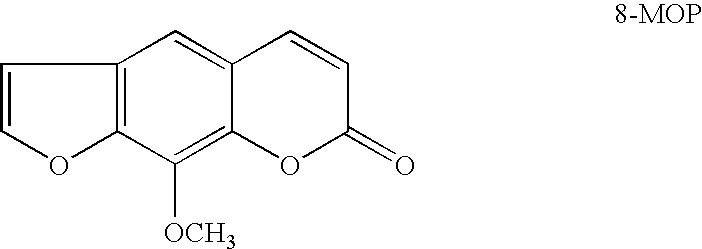Phototherapy compositions and methods
a technology of compositions and compositions, applied in the field of topical compositions of photoactivable agents and agents, can solve the problems of nausea, difficulty in achieving the therapeutic level of psoralen, and many adverse effects
- Summary
- Abstract
- Description
- Claims
- Application Information
AI Technical Summary
Problems solved by technology
Method used
Image
Examples
example 1
Preparation of Compositions
[0061] Two oil-in-water formulations containing methoxsalen (8-methoxypsoralen—UV photosensitizer) and octylmethoxycinnamate (UVB sunscreen) were prepared. One formulation contained 0.09% methoxsalen, the second contained 0.01% methoxsalen. Both creams contained 7.5% octymethoxycinnamate.
[0062] The compositions were prepared as follows:
Water Phase
[0063] 1. Tare main container. To this, add DI water.
[0064] 2. Add Carbopol 934 slowly with propeller agitation, mix until uniform.
[0065] 3. Add rest of water phase ingredients, and heat to 80 C., mix until uniform.
[0066] 4. Hold at 80 C. for phasing
Oil Phase
[0067] 1. Into another beaker add oil phase ingredients and heat to 80 C., with propeller mixing.
[0068] 2. Mix until uniform, and hold for phasing.
Phasing
[0069] 1. When both phases are at 80 C. and uniform, add oil phase into water phase.
[0070] 2. Continue to mix until uniform.
[0071] 3. When batch is uniform, cool to 45 C. and QS with water.
[...
example 2
Skin Photosensitization
[0077] Both formulations were tested for ability to photosensitive human skin when applied topically followed by UVA exposure. The creams were applied to the skin of a healthy male, human volunteer and to which UVA was then applied.
[0078] The UVA exposure source was a 100 W xenon arc solar simulator filtered with WG345 Schott filter. Without a photosensitizer, the UVA dose required for an erythema reaction is approximately 40 J / cm2. This filtration system eliminates virtually all radiation from the source (radiation below 340 nm). This is unlike the fluorescent UVA lamps used for PUVA therapy which contain both UVA2 and UVA1, as well as 2% UVB radiation. Comparisons of the efficacy of these two sources using an 8-MOP action spectrum (Cripps BJID 107:77-82. 1982) shows that the fluorescent PUVA bulbs are 2.25× more effective than the solar simulator source used in the following experiments. Therefore, estimated equivalent exposures for PUVA phototherapy lamps...
example 3
Dose Response Study
[0084] A dose response study of UVA exposures with topical creams containing 0.1% wt (high dose) and 0.01% wt. (low dose) 8-MOP was conducted to determine UV dose requirements in a Yucatan mini-pig. This minimum response (tanning) dose was delivered on 5 occasions over a two-week period. Increased pigmentation and the duration of this pigmentation were evaluated over the subsequent three-month time period. UVB exposures (without the cream) were also evaluated.
[0085] Subjects were treated 2-3 times per week for a total of 6 treatments with UVA doses of 15 minutes or 30 minutes. Pigmentation induction was monitored with Chromameter Photographs. Pigmentation regression was also monitored in this manner. UVA (approx. 350 nm with a minor peak at approx. 320 nm) was generated from a.lamp bank of 8, 40 W F40350 lightbulbs. Total UVA irradiance at the exposure plane was approximately 18 mW / cm2 For UVB, a Schott WG320 1 mm filter was interposed between the lamps and the ...
PUM
| Property | Measurement | Unit |
|---|---|---|
| irradiance | aaaaa | aaaaa |
| irradiance | aaaaa | aaaaa |
| area | aaaaa | aaaaa |
Abstract
Description
Claims
Application Information
 Login to view more
Login to view more - R&D Engineer
- R&D Manager
- IP Professional
- Industry Leading Data Capabilities
- Powerful AI technology
- Patent DNA Extraction
Browse by: Latest US Patents, China's latest patents, Technical Efficacy Thesaurus, Application Domain, Technology Topic.
© 2024 PatSnap. All rights reserved.Legal|Privacy policy|Modern Slavery Act Transparency Statement|Sitemap

